Have you ever wondered about the true essence of a ginger flower? Its delicate beauty, enchanting fragrance, and vibrant colors evoke a sense of intrigue and fascination. But what if I told you there is one ginger flower that surpasses them all – the Hedychium Gardnerianum, also known as the ‘Ginger Lily’? Prepare to be captivated by its dramatic presence and discover why it is revered as the queen of tropical plants.
Appearance of Hedychium Gardnerianum


Hedychium Gardnerianum, also known as the ‘Ginger Lily‘, is a stunning tropical plant that adds a touch of exotic beauty to any garden. With its tall stems reaching up to 8 feet in height, this large herbaceous plant is sure to make a statement.
The lance-shaped leaves of Hedychium Gardnerianum are glossy green on the upper surface and powdery-white below, creating a striking contrast. These lush leaves provide an elegant backdrop for the magnificent flower spikes that appear in late summer or early fall.
“The showy flower spikes of Hedychium Gardnerianum are truly breathtaking. Each spike can bear up to 50 yellow flowers that emerge from cylindrical cones of green bracts. This captivating display adds a vibrant burst of colour to your garden.”
But the beauty of Hedychium Gardnerianum doesn’t end with its flowers. This tropical plant also produces thin-walled orange capsules that eventually split open, revealing small, shiny bright red seeds. These seeds add an element of interest and intrigue to the overall appearance of the plant.
Ginger Lily Varieties
In addition to Hedychium Gardnerianum, there are other ginger lily varieties that are equally captivating. The white ginger lily (H. coronarium), yellow ginger (H. flavescens), and red ginger (H. coccineum) are some of the popular choices among gardeners.
Some varieties, such as ‘Verity‘, even feature variegated foliage, adding a touch of uniqueness to your garden. These ginger lily varieties offer a wide array of flower colors, allowing you to create a diverse and visually stunning garden.
If you’re looking to add tropical flair to your garden, then ginger lilies are the perfect choice. These exotic plants will not only beautify your outdoor space but also create an enchanting and vibrant atmosphere.
- Tall stems reaching up to 8 feet in height
- Lance-shaped leaves with a glossy green upper surface and powdery-white underside
- Showy flower spikes with up to 50 yellow flowers
- Thin-walled orange capsules that split open to reveal small, shiny bright red seeds
 The Ginger Lily (Hedychium gardnerianum) is valued for both its beauty and medicinal uses. Native to the Himalayas, its rootstocks are known for anti-inflammatory and pain relief properties, illustrating the plant’s practical benefits alongside its ornamental appeal.
The Ginger Lily (Hedychium gardnerianum) is valued for both its beauty and medicinal uses. Native to the Himalayas, its rootstocks are known for anti-inflammatory and pain relief properties, illustrating the plant’s practical benefits alongside its ornamental appeal.
Light Requirements for Ginger Lily
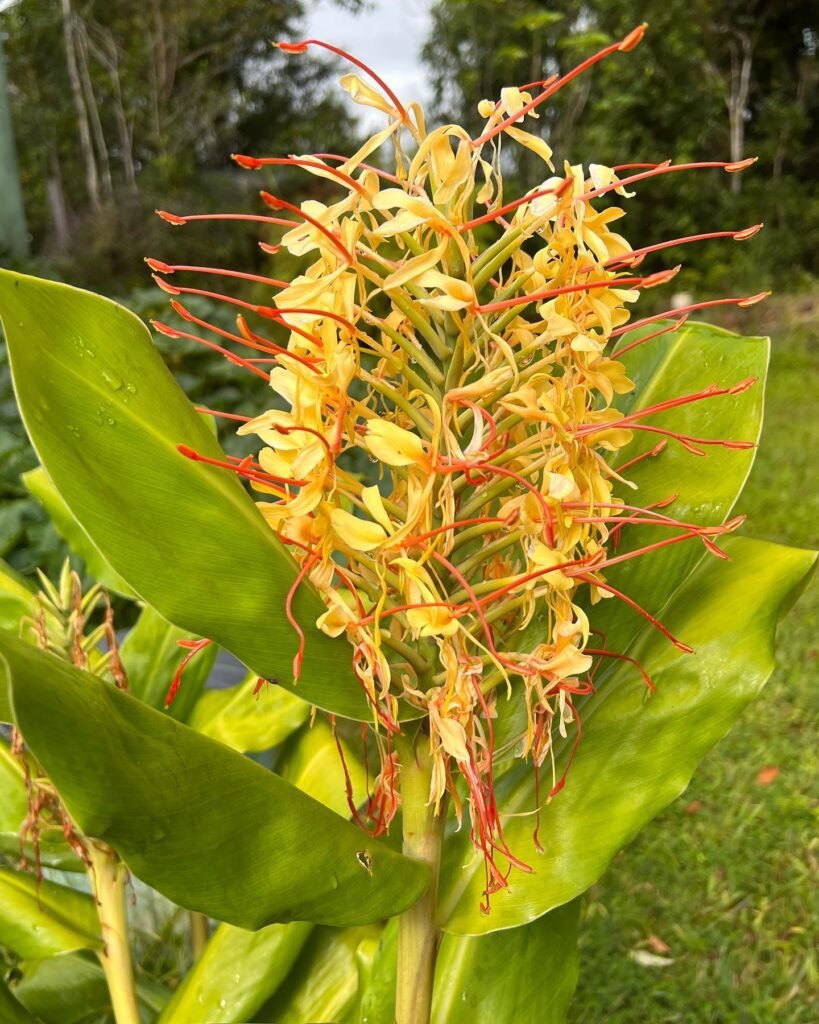

When it comes to growing the beautiful Hedychium Gardnerianum, also known as the ‘Ginger Lily‘, lighting is a crucial factor to consider. This tropical flower thrives best when exposed to full sun to partial shade. In its natural habitat, it enjoys the dappled shade provided by the tree canopy.
For those of us in the UK, it is important to find the ideal spot that strikes a balance between sun and shade. Find a location that receives sun at the beginning and end of the day, while being protected from the intense midday sun. This will provide the perfect lighting conditions for the Ginger Lily to flourish.
It is worth noting that excessive sun exposure can have adverse effects on the Ginger Lily. When grown in too much sun, the leaves may roll up to prevent water loss and may develop dry, papery patches. Hence, it is essential to provide a balance of light throughout the day for optimal growth.

Watering Tips for Hedychium Gardnerianum
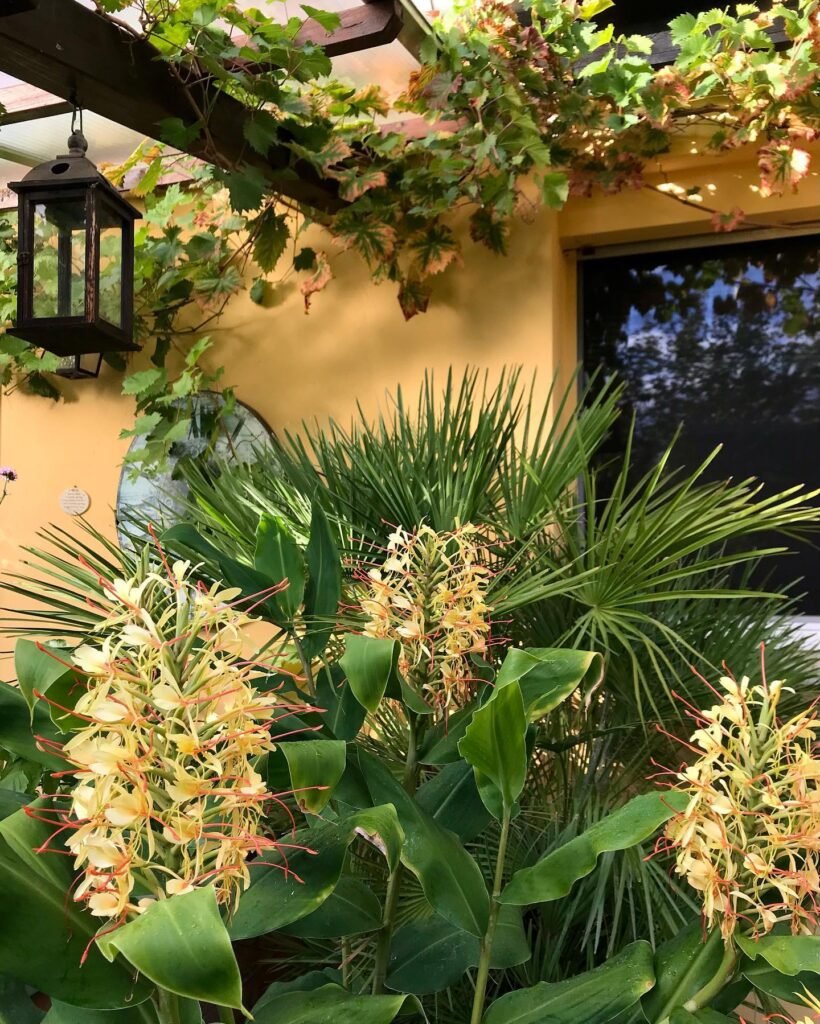
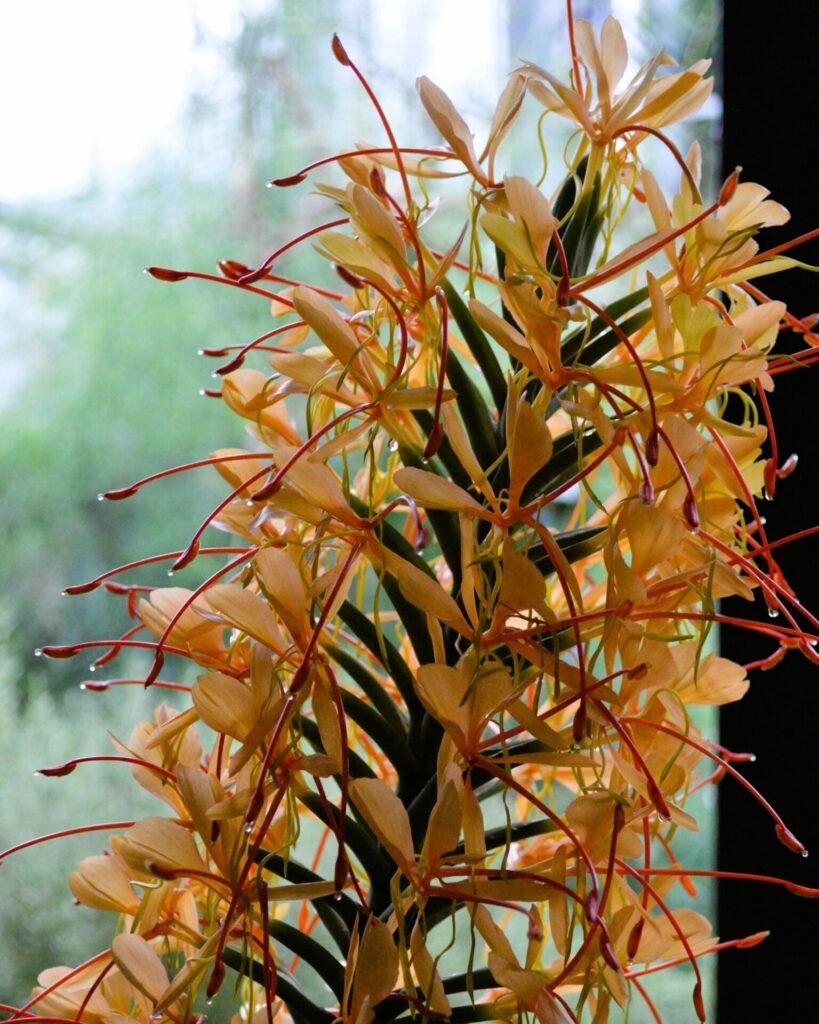
Hedychium Gardnerianum, or the ginger lily, requires proper watering to ensure its lush growth and vibrant blooms. Here are some essential watering tips to keep your ginger lily thriving:
1. Maintain Moist Soil
To mimic the plant’s natural habitat and promote healthy growth, it is important to keep the soil consistently moist throughout the growing season. The ginger lily is accustomed to ample summer rainfall, so regular watering is key. Aim to provide enough moisture to keep the soil damp but not waterlogged.
2. Avoid Standing Water
Although the ginger lily can tolerate short periods of drought, it is crucial to prevent the plant from standing in water. Adequate drainage is essential to avoid root rot and other water-related issues. Ensure that the planting area or container has proper drainage holes to allow excess water to escape.
3. Reducing Watering in Winter
During the winter months, when the ginger lily is in its dormant stage, you should reduce the frequency of watering. The plant’s water requirements decrease during this time, so it is important to avoid overwatering, as it can lead to root rot. Allow the top few inches of soil to dry out before watering again.
4. Observe the Plant’s Needs
While these general watering tips are helpful, it is important to pay attention to the specific needs of your ginger lily. Factors such as temperature, humidity, and the type of soil can influence its water requirements. Monitor the moisture level in the soil and adjust your watering routine accordingly.
“Proper watering is essential for the health and vitality of your ginger lily. By maintaining moist soil, avoiding standing water, and adapting your watering routine based on the plant’s needs, you can ensure the best care for your ginger lily.”

Fertilizing and Soil for Ginger Lily


Hedychium Gardnerianum, known as the ‘Ginger Lily‘, is an exquisite ornamental plant that adds a touch of tropical beauty to any garden. To ensure its lush growth and vibrant blooming, proper fertilizing and soil preparation are essential.
Firstly, it is important to choose a well-drained soil that mimics the natural habitat of the Ginger Lily. Opt for a humus-rich soil that retains moisture without becoming waterlogged. This will provide an ideal environment for the plant’s roots to thrive.
Regular fertilizing is necessary to supply the Ginger Lily with the nutrients it needs for optimal growth. Organic fertilizers, such as compost or well-rotted organic matter, provide a gentle and sustainable source of nutrients. These enrich the soil and support the plant’s overall health.
“A well-fed Ginger Lily rewards you with abundant foliage and stunning flowers.”
Incorporate a layer of compost or organic matter into the top few inches of soil before planting the Ginger Lily. This will fortify the soil, improving its structure and fertility. Additionally, it will ensure a consistent supply of nutrients to the plant as it grows.
I recommend applying a balanced slow-release granular fertilizer in the spring, following the manufacturer’s instructions. This will provide a steady release of nutrients throughout the growing season, promoting lush foliage and prolific flowering.
Regularly monitor the soil moisture levels and fertilize the Ginger Lily accordingly. During periods of active growth, an additional application of liquid fertilizer every two to three weeks can be beneficial. This will provide a quick nutrient boost and help sustain the plant’s vigor.
Remember to water the Ginger Lily deeply after fertilizing to ensure that the nutrients reach the plant’s root zone. Mulching around the base of the plant helps conserve soil moisture and prevent weed growth, creating an optimal environment for the Ginger Lily to thrive.
Summary:
- Choose a well-drained, humus-rich soil for the Ginger Lily.
- Incorporate compost or organic matter into the soil before planting.
- Apply a balanced slow-release granular fertilizer in the spring.
- Supplement with regular applications of liquid fertilizer during active growth.
- Monitor soil moisture levels and water deeply after fertilizing.
- Mulch around the base of the plant to conserve moisture and suppress weeds.

Pruning and Maintenance for Ginger Lily
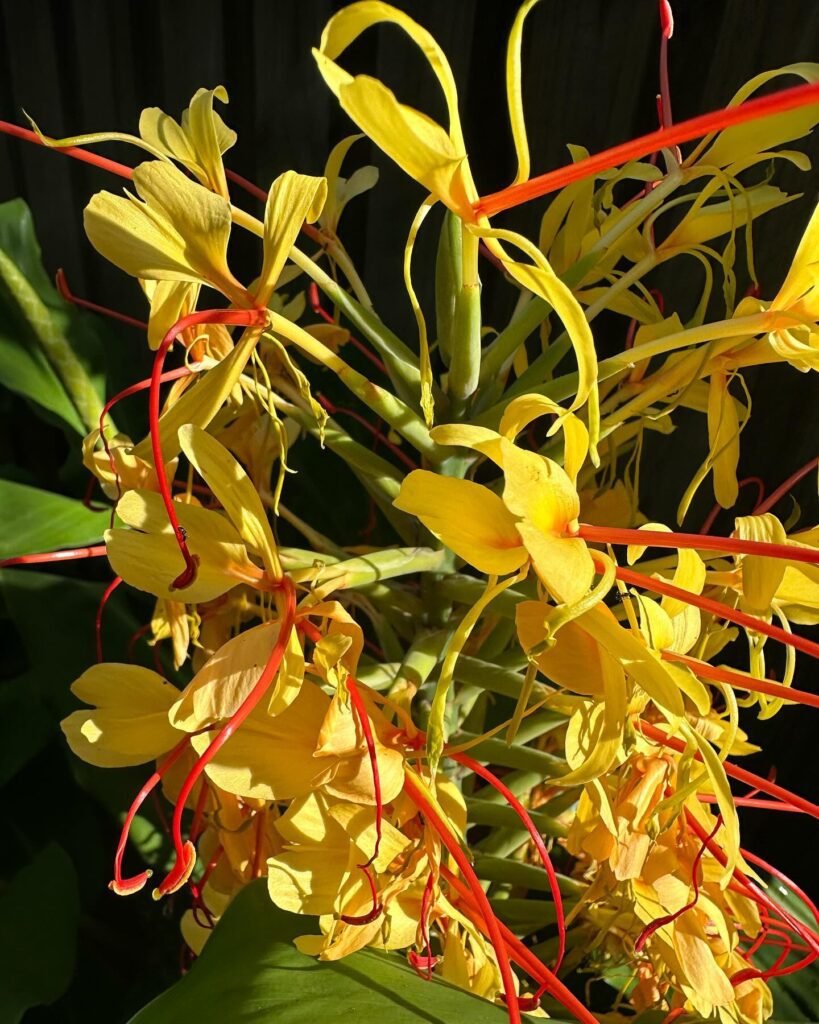
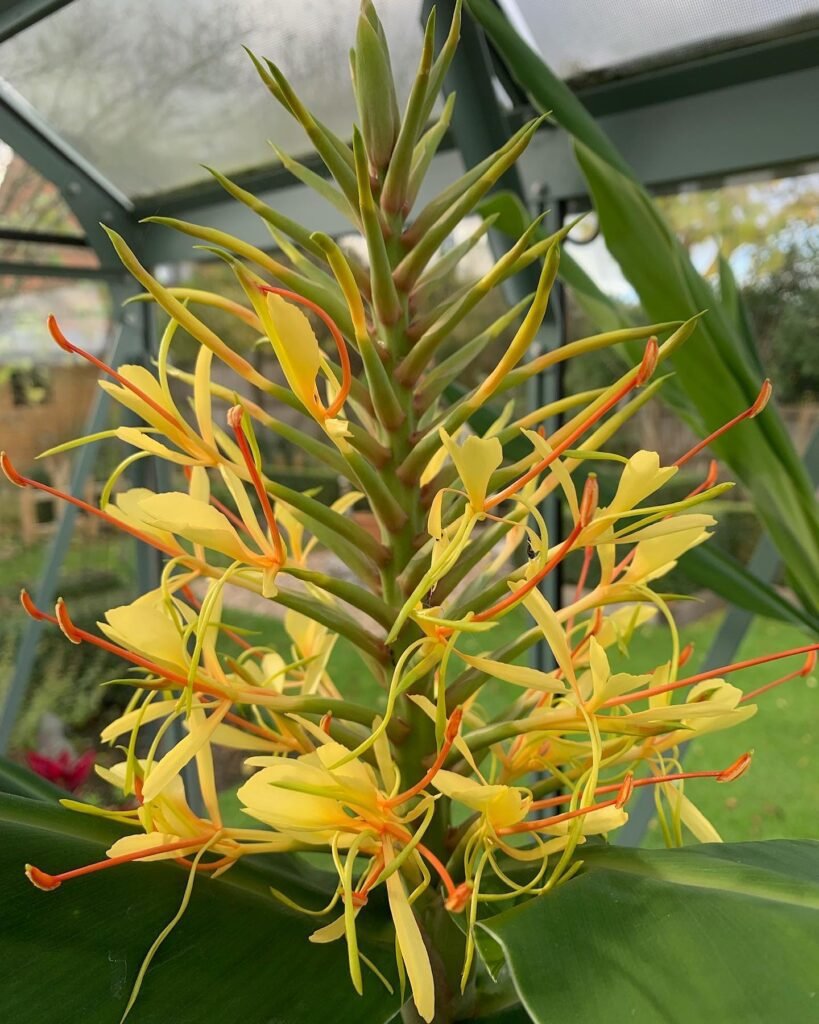
When it comes to caring for your Hedychium Gardnerianum, pruning and maintenance are relatively simple tasks. The ginger lily’s attractive foliage remains eye-catching even when it’s not in bloom, making it a wonderful addition to any garden. However, to ensure its continued beauty, a few practices should be followed.
Maintaining Appearance
At the end of the flowering season, it is recommended to trim back the old flower spikes and foliage of the ginger lily. This will help maintain an aesthetically pleasing appearance and encourage healthy growth. Simply snip off the faded flower spikes at their base and remove any dead or damaged leaves.
Regular Care
In addition to pruning, regular maintenance plays a crucial role in keeping your ginger lily vibrant and healthy. Take the time to inspect the plant regularly and remove any dead or damaged leaves promptly. This will not only enhance the overall appearance, but also promote better air circulation and reduce the risk of disease.
Remember to check for pests, such as aphids or spider mites, as they can cause damage to the foliage. If necessary, treat affected plants with appropriate organic pest control methods.
Tips for Landscaping
When considering the landscaping aspect of ginger lily care, it’s important to plan its placement strategically. The ginger lily can be used as a focal point, adding height and tropical charm to your garden or outdoor space.
“The ginger lily’s lush foliage and vibrant flowers make it an excellent choice for landscaping projects. Whether planted alongside other tropical plants or placed as a standalone specimen, it brings a touch of paradise to any setting.”
Consider combining the ginger lily with other tropical plants to create a lush and vibrant landscape. Its dramatic height and delightful scent make it a standout choice for borders, rock gardens, or even large containers.
- Tip: To create a stunning visual impact, plant ginger lilies in clusters or groups. This will allow their bright yellow flowers to create a striking display and draw attention to the area.
- Tip: Ensure that the ginger lily is well-watered, particularly during dry spells, to maintain its healthy growth and vivid blooms.
- Tip: Mulching the soil around the base of the ginger lily can help retain moisture and suppress weed growth, further enhancing its overall appearance.

Propagating Hedychium Gardnerianum


Propagating Hedychium Gardnerianum, also known as the ginger lily, can be done through division or from seed. Both methods have their advantages and can be successful in creating new plants.
Division
Dividing the rhizomes of ginger lily is a simple and effective way to propagate this exotic plant. In the spring, when new growth appears, carefully dig up the plant and separate the rhizomes into sections. Each section should have at least one growing tip to ensure successful growth. Allow the cut rhizomes to dry for a day or two before planting them in well-draining soil.
“Dividing the rhizomes is a tried-and-tested method of ginger lily propagation. It allows you to multiply your plant collection and share the beauty of this exotic plant with others.”
Seeds
Growing ginger lily from seed is a longer process but can be rewarding. Collect mature seeds from the plant as soon as they are ripe. Soak the seeds in warm water for a few hours or overnight to improve germination rates. Plant the seeds in a well-draining potting mix and keep them moist. It may take several years for the seedlings to reach the blooming stage, but with patience, you can enjoy the beauty of these exotic plants in your garden.
- Division is an easy way to propagate ginger lily, ensuring that each new plant has a healthy growing tip.
- Growing from seed may take longer, but it allows for the production of numerous plants that will eventually bloom.

Repotting Tips
When it comes to caring for your ginger lily plant, proper repotting is essential for its health and growth. Whether you choose to grow your ginger lily in containers or in the ground, here are some helpful tips to ensure successful repotting:
1. Choose the right container
If you opt for growing your ginger lily in a pot, make sure to select a large and sturdy container. The size of the container should accommodate the plant’s large rhizomes, allowing them room to spread and grow.
2. Determine the repotting frequency
Depending on the growth rate of your ginger lily, you may need to repot it every year or every few years. Keep an eye on the plant’s size and root system to gauge when it’s time for repotting.
3. Divide the rhizomes if necessary
During the repotting process, it may be necessary to divide the rhizomes of your ginger lily. This can help control the plant’s size and promote healthier growth. Ensure each section of the rhizome has at least one growing tip for optimal propagation.
4. Repot in early spring
The best time to repot your ginger lily is in early spring, just before the growing season begins. This will give the plant ample time to settle into its new container and encourage vigorous growth.
5. Provide a warm location
After repotting, place your ginger lily in a warm location to promote its growth. This can be indoors near a sunny window or in a greenhouse if the weather conditions are still too cold outside. Once the danger of frost has passed, you can move your ginger lily back outdoors.
 The Ginger Lily, or Hedychium gardnerianum, is famed for its vivid yellow, sweet-smelling flowers that appear late summer to autumn. It originates from the Himalayas and can reach up to 6 feet, with lush foliage. It attracts butterflies, boosting garden biodiversity.
The Ginger Lily, or Hedychium gardnerianum, is famed for its vivid yellow, sweet-smelling flowers that appear late summer to autumn. It originates from the Himalayas and can reach up to 6 feet, with lush foliage. It attracts butterflies, boosting garden biodiversity.
Varieties of Ginger Lily
In addition to Hedychium Gardnerianum, there are other ginger lily varieties that are commonly cultivated. These include white ginger (H. coronarium), yellow ginger (H. flavescens), and red ginger (H. coccineum). Some varieties, such as ‘Verity‘, have variegated foliage. Each variety has its own unique characteristics and flower colors, adding diversity to the garden.
Growing Ginger Lily in the UK
If you’re a gardening enthusiast in the UK and want to add a touch of tropical beauty to your garden, consider growing the stunning Ginger Lily (Hedychium Gardnerianum). While native to tropical regions, this versatile plant can thrive in the UK as well, making it a fantastic choice for a seasonal or container plant.
Ginger Lily is best suited for USDA hardiness zones 8-11, which includes several areas in the UK. To ensure its successful growth, it’s important to provide the plant with the right conditions. One key factor is providing ample moisture, as the Ginger Lily enjoys moist soil throughout the growing season. Regular watering is essential, but be cautious not to let the plant stand in water, as this can lead to root rot.
In addition to moisture, the Ginger Lily also benefits from regular fertilization. Rich soil, supplemented with organic matter such as compost, will provide the necessary nutrients for lush growth and blooming. It’s best to fertilize during the growing season, following the instructions on the fertilizer packaging.
When planting the Ginger Lily, choose a suitable growing medium that mimics its natural habitat. Well-drained, humus-rich soil will ensure the plant’s overall health and vigor. Consider growing it in a container if you live in a colder region, as this allows for easier control of its growing conditions.
Helpful Videos about Hedychium Gardnerianum (Ginger Lily)
Have a look at these great videos I’ve picked out on looking after Hedychium gardnerianum. They’re full of tips to make caring for your plant really simple. Perfect if you’re wanting to get better at gardening!
- How to Grow Hardy Gingers for Amazing Scented Tropical Flowers! Hedychium gardnerianum Tips
- Top 5 plants for August in Zone 7: Ginger Lily
FAQ about Hedychium Gardnerianum (Ginger Lily)

Got questions about growing and caring for your Hedychium Gardnerianum? You’re in the right spot! I’ve gathered the most common questions to help you keep your Ginger Lily looking lovely. From watering doubts to sorting out those leaves, I’ve got the answers.
They love partial shade to full sun. Too much direct sun might scorch the leaves, so a spot with morning sun and afternoon shade is ideal.
Keep the soil consistently moist, especially during the growing season. In winter, you can reduce watering.
They thrive in rich, well-draining soil with plenty of organic matter.
They typically flower from late summer to early autumn, offering beautiful and fragrant blooms.
They can reach up to 6 feet tall or more, depending on the care and conditions.
Yes, feed it with a balanced, slow-release fertilizer during the growing season to support its growth.
Absolutely! Just make sure the pot is large enough and has good drainage.
The easiest way is by dividing the rhizomes in spring just before the growing season starts.
No, they’re not frost-tolerant. If you live in a cooler climate, provide protection in winter or bring potted plants indoors.
After flowering, cut back any dead or yellowing stems to encourage new growth.
Keep an eye out for slugs and snails, especially in damp conditions. Aphids and red spider mites can also be a problem.
Yellow leaves can be a sign of overwatering, poor drainage, or a nutrient deficiency. Check the soil and adjust your care as needed.
While they can tolerate some wind, strong winds might damage the leaves, so a sheltered spot is best.
It could be due to insufficient sunlight, overfeeding, or the plant’s age. Ensure it gets enough light and follow feeding recommendations.
Ginger Lily is not known to be toxic to pets, but it’s always best to prevent pets from eating plants.
They’re great as a focal point in a tropical-themed garden or planted in groups along borders for a lush, dramatic effect.
Provide them with ideal growing conditions: partial shade, moist soil, and regular feeding during the growing season.
I hope this FAQ lights up the way to looking after your Hedychium Gardnerianum (Ginger Lily). If I’ve missed your question, no bother! Just drop it in the comments, and I’ll do my best to sort you out. Remember, every plant parent starts somewhere, and there’s always a bit more to pick up on the journey of growing with your green mates.





